Chapter 3 Human Relation Questions and Answers
Question 1. What do you understand by Self-understanding?
Answer:
Definitions of Understanding Self: Understanding self represents the total of people’s conscious perception of their identity as distinct from others. It is not a static phenomenon but continues to develop and change throughout our lives. The understanding self is thinking about what is involved in being. What distinguishes you from being an object, an animal, or a different person?
Self-understanding is important because when we have a better understanding of ourselves, we can experience ourselves as unique and separate individuals. We are then empowered to make changes and to build on our areas of strength as well as identify areas where we would like to make improvements.
Read And Learn More: Bsc Nursing 2nd Year Communication And Education Technology Previous year Question and Answers
Importance of understanding self
- Self-understanding has been recognized as a key competency for individuals to function the organizations efficiently. It influences an individual’s ability to make key decisions about self, others around, and organizations. As a result, it influences our effectiveness in work, the directions taken in our lives, and our degree of fulfillment.
- Understanding the self equips individuals with making more effective career and life choices, the ability to strengthen relationships with others in their personal and professional lives, and their ability to lead, guide, and inspire with authenticity resulting in significantly improved organizational productivity.
- Self-understanding can be accomplished by assessing an individual’s personality preference, interests, values, skills, conflict style, learning style, leadership style, and life experiences.
- It is usually formed first and is related to the child’s physical appearance, attractiveness, sex appropriateness, the importance of the different body parts to behavior, and the percentage they give the child in the eyes of others.
- An individual body image is a personal appraisal of his or her physical being and includes physical attributes, functioning, sexuality, wellness- illness state, and appearance. It is an integrated collection of visual, auditory, and tactile information that combines with effective and cognitive processes to form an image of one’s physical self.
Psychological Self-Image:
- It is based on thoughts, feelings, and emotions.
- They consist of the qualities and abilities that affect adjustment to life such as courage, honesty, independence, and self-confidence.
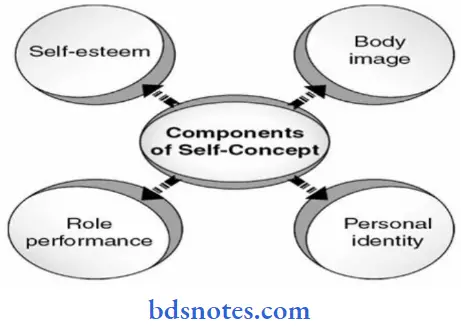
Psychological Self-esteem:
- It refers to the degree of regard or respect that individuals have for them and is a measure of worth that they place on their abilities and judgment.
- Self-esteem is closely related to the other components of self-respect.
Personal Body Image:
- An individual body image is a personal appraisal of his or her physical being and includes physical attributes, functioning, sexuality, wellness- illness state, and appearance.
- It is an integrated collection of visual, auditory, and tactile information that combines with effective and cognitive processes to form an image of one’s physical self.
Question 2. Social behavior
Answer:
Social behavior: The interaction between members of the same species or the behavior directed towards the society is known as social behavior. Communication between members of two different species is not social behavior.
It is an activity that has a social meaning or context. In a sociological hierarchy, social behavior is followed by social actions, directed at other people, and is designed to provoke a response. Antisocial behavior refers to behavior that may cause harm to society.
Types of social behavior: Some selected social behaviors manifested by individuals are discussed below:
Social Behavior Aggression: This refers to the behavior between members of the same species to hurt, ridicule, or humiliate the other person. Ferguson and Beaver (2009) defined aggressive behavior as behavior that is intended to increase the social dominance of the organism relative to the dominant position of other organisms.
Social Behavior Altruism: Altruism refers to a feeling of concern, sympathy, and benevolence for others. It is a traditional virtue in some cultures or can be an inbuilt part of religious expectations that the followers feel motivated for.
Social Behavior Scapegoating: Scapegoating is the practice of isolation of any party for derogatory or negative treatment or blame. Anyone can be prey to scapegoating, a child, peer, cultural or ethnic group, worker, or country.
Social Behavior Shyness: Shyness is a feeling of discomfort, nervousness, lack of confidence, or awkwardness when a person is in proximity (especially in a situation where one has to deal) to an unfamiliar person.
An unusually high feeling of shyness is referred to as social phobia.
Factors influencing social behavior: The way men behave is largely determined by their relation to each other and by their membership in groups. Culture also plays a central role in determining the social behavior of individuals.
- Social norms: The behavior of individuals is largely influenced by social norms. Different societies have different social norms that are primary influences on the behavior of an individual. For example, a woman does not communicate freely in the presence of her father-in-law in North Indian societies.
- Culture and social customs: Culture and social customs are other important factors influencing an individual’s social behavior. For example, it is culturally not permitted to talk to elders with eye contact in Indian society. In Western societies, however, talking to elders without maintaining proper eye contact is considered a sign of disrespect.
- Social Behavior Values: Individuals carry specific inherent values acquired from their parents, family, mentors, and educational institutions. These inherent values significantly influence the social behavior of individuals. For example, an individual having a value of not disobeying or arguing with anyone superior to him in the hierarchy, either at work or community, is going to be governed by the values he or she owes.
- Social Behavior Traditions: Different societies have different traditions that are largely responsible for the overall social behavior of individuals. For example, newly married women are expected to wear a particular type of dress and behave in a particular manner in some North Indian societies. Such traditions are certainly responsible for an individual’s social behavior.
- Social Behavior Motives: An individual’s motive also significantly influences his or her social behavior because motive governs the attitude as well as the psyche of an individual
- Social Behavior Drives: Drive may be defined as an aroused awareness, tendency, or a state of heightened tension in individuals that sets off reactions and sustains the reactions for increasing the general activity level of individuals. The drive starts from within the individuals and directs them to do things that may bring about the satisfaction of that need. The strength of a drive depends upon the strength of the stimuli generated by the related need.
- Social Behavior Ambitions: An individual’s ambition influences social behavior as it gives a way to expect and respond to others. Unmotivated people exhibit sluggish social behavior while ambitious people may display warm and proactive social behavior.
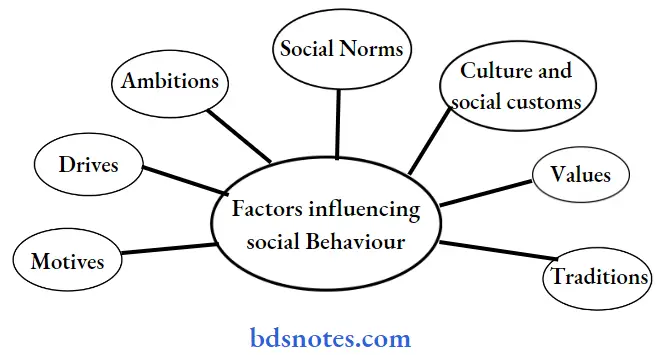
Question 3. Define Human relations. Importance of Human relations in nursing
Answer:
Human relations are fundamental in civil society and each profession (including psychology, social work, and health care). Nurses are one of the largest groups in the healthcare workforce and are constantly interacting with patients, their relatives, colleagues as well as other members of the multidisciplinary healthcare team inside and outside the healthcare organization.
Human relations refers to the science of applying principles of social psychology in improving the working of an organization to make it more productive and in making the worker happier to improve efficiency and satisfaction. Human relations are the relations between human beings that are affected by many other factors and help in the accomplishment of the goals of an organization.
Human relations in nursing: Human relations in nursing refer to the relationship of nurses with colleagues and other department personnel and of nurses with patients.
- Professional relationships are created through the nurse’s application of knowledge and understanding of human behavior as well as his or her communication and commitment to ethical behavior.
- Nurse-patient helping relationships: Helping relationships are the foundations of clinical nursing practice. The nurse assumes the role of a professional helper in such relationships and comes to know the patient as an individual with unique health needs, human responses, and patterns of living. The nurse’s therapeutic use of communication helps patients overcome their problems by achieving optimum health.
- Nurse-family relationships: Many nursing situations, especially those in community and home care settings, require the nurse to form helping relationships with the patient’s entire
- Nurse-family relationships: Many nursing situations, especially those in community and home care settings, require the nurse to form helping relationships with the patient’s entire family.
- Nurse-community relationships: Many nurses form relationships with community groups by participating in local organizations, volunteering for community service, or becoming politically active nurses in a community-based practice. They must be able to establish relationships with their community to be effective change agents.
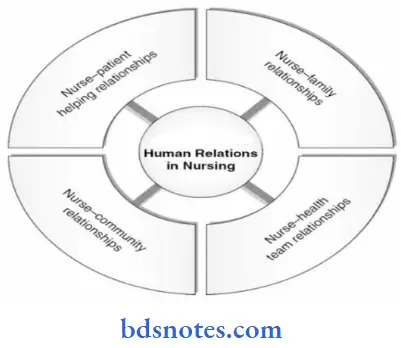
Question 4. Explain the strategies to develop effective human relations in the context of nursing.
Answer:
Strategies to promote cardinal human relations: Creating positive human relations in an organization is not an easy task. However, they can be created and promoted with the help of the following suggested strategies:
- Common organizational goals: There must be promotion of a common goal perception in personnel working in an organization so that human relations can be strengthened further.
- Group cohesiveness: Group cohesiveness in the personnel may help generate the ‘we’ feeling and promote positive human relations in a group of workers.
- Effective communication practices: Effective communication practices in an organization are the key to establishing positive human relations. Therefore, to create a positive human relations environment in an organization, it is essential to practice efficient communication practices.
- Defined organizational structure: A well-defined organizational structure can affect human relations in an organization. There should be a sound organizational structure mentioning duties, expectations, and job responsibilities clearly for everyone.
- Strengthening a sense of oneness: Inculcating and strengthening a sense of oneness in employees in an organization helps establish positive human relations, which ultimately benefit the organization achieve organizational goals.
- Training and skill building in human relations: In the modern healthcare industry, it is believed that employees can be trained and their skills built in human relations to achieve a constructive organizational environment.
- Policies to promote coordination and cooperation among employees: Each institution must have policies and procedures to promote coordination and cooperation among their employees so that a positive human relation milieu can be created. To have effective human relations, the policy framer should keep in mind that human beings have emotions, drives, thoughts, and feelings (the instinct of security and possession, etc.).
Question 5. Define motivation.
Answer:
Motivation is derived from the Latin word movere which means ‘to move’ or ‘to energize’ or ‘to activate’. It is a process that produces energy or drives in the individual to proceed with an activity.
Definitions of motivation: Motivation is the process of arousing the action, sustaining the activity in the process, and regulating the pattern of activity. Motivation refers to the states within a person or animal that drives behavior toward some goals.
Concept of motivation
- Motivation refers to sparking the personnel with zeal to perform a task for the achievement of established organizational goals. Motivation is not restricted to the sole achievement of a goal.
- In fact, it inculcates the spirit of working efficiently and wholeheartedly with grit to achieve desired objectives. To accomplish this level of work, the manager needs to give positive reinforcement to various personnel.
- The manager has to be consistent in figuring out areas of deficit and lack of infrastructure and provide incentives and perks with the desired appreciation to keep the personnel’s morale high for a fruitful result.
- Apart from providing incentives, making the personnel more decisive and giving exposure to the best circumstances also prove to be lubricants for having a fruitful outcome. In addition, personnel’s individuality cannot be neglected and they should be provided with freedom of expression and a chance to work the way they want.
Question 6. Classify motives.
Answer:
According to Maslow, each of us is motivated by needs. Our most basic needs are inborn, having evolved over tens of thousands of years. The model helps explain how these needs motivate all of us. It states that we must satisfy each need, starting with the first need that deals with the most obvious need, for survival itself.
Only when the lower-order needs of physical and emotional well-being are satisfied are we concerned with the higher-order needs of influence and personal development. Conversely, if the things satisfying our lower-order needs are swept away, we are no longer concerned about the maintenance of our higher-order needs.
The original version of this model consists of five needs discussed below:
- Basic physiological needs: The needs related to the existence and maintenance of human life are our basic physiological needs. These include things such as food, clothing, shelter, air, water, and other necessities of life.
- Safety and security needs: After being content with basic needs, there is a drift towards financial and personal security and insurance.
- Social needs: After the satisfaction of our security needs, our needs move towards being social. These needs include interaction, adoration, respect, belongingness, etc.
- Esteem and status needs: These needs include self-respect, reputation, confidence, self-reliance, achievement, finesse, etc., and take priority after our social needs are met.
- Self-realization: Self-realization refers to the need to realize personal potential, self-fulfillment, seek personal growth, and peak experiences. Achievement of these needs gives a high degree of contentment, and complacency if they prove to be an uphill task to perform.
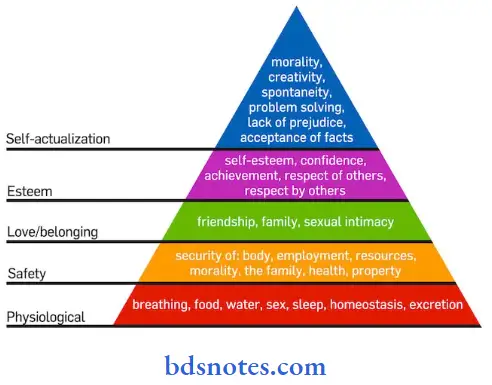
Question 7. Discuss the group dynamics and basic stages of group development.
Answer:
Group Dynamics: “Never doubt that a small group of thoughtful citizens can change the world. Indeed, it is the only thing that ever has” – Margaret Mead Kurt Lewin, Social Psychologist is the founder of Group Dynamics.
- Group dynamics is a critical factor in group performance. Understanding how the group works and if and how it is developing will help the team leader to lead the team better. In organizational development context.
- The need for managing or improving the group dynamic will lead to an intervention best consulting project where tools such as team building or socio-mapping are used.
Group Dynamics Definitions: The social process by which people interact and behave in a group environment. The study of group and also a general term for foreign group process.
- Group Development ‘The appointment of individuals to a group based on their compatibility, diversity, or expertise does not assure effectiveness in achieving group goals.
- A group is initially a collection of personalities with different characteristics, needs, and influences. To be effective, these individuals must spend time acclimatizing themselves to their environment, the task, and to each other.
- Stages Organizational experts and practitioners have observed that new groups go through several stages before they achieve maximum performance. Each stage presents the members with different challenges that must overcome before they can move on to the next stage.
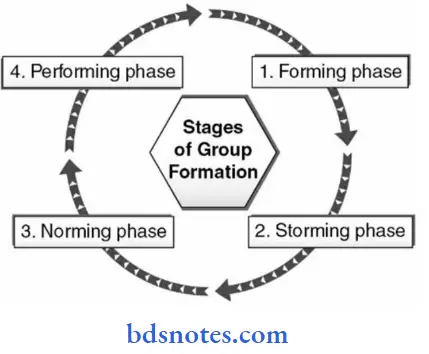
These Group Dynamics stages are
1. Group Dynamics Forming: At this first stage of development, members are preoccupied with familiarizing themselves with the task and to other members of the group. This is sometimes referred to as the dependent stage, as members tend to depend on outside expertise for guidance, job definition, and task analysis.
2. Group Dynamics Storming: At this stage, the group encounters conflict as members confront and criticize each other and the approach the group is taking to their task. Issues that arise include the identification of roles and responsibilities operational rules and procedures and the individual need for recognition of his / her or her skills and abilities.
This stage is also referred to as the “Counter dependent stage where members tend to” flex their muscles in search of identity. In some cases, the group may have problems getting through this stage. This may occur if the group encounters difficulty clarifying their task, agreeing on their mission or mandate, or deciding how they will proceed. Lack of skills, ability, or aptitude can also contribute to their inability to get beyond this stage.
3. Group Dynamics Norming: At this point, members start to resolve issues that are creating the conflict and begin to develop their social agreements. The members begin to recognize their interdependence, develop cohesion, and agree on the group norms that will help them to function effectively in the future.
4. Group Dynamics Performing: When the group has sorted out its social structure and understands its goals and individual roles, it will move towards accomplishing its task. Mutual assistance and creativity become prominent themes at this stage. The group, sensing its growth and maturity, becomes independent, relying on its own resources
5. Group Dynamics Adjourning: During this phase, the group will resort to some form of closure that includes rites and rituals suitable to the event. These may include social practice ceremonies that exhibit emotional support or celebration of the success.
Question 8. Importance of Teamwork in Nursing.
Answer:
Teamwork divides the task and multiplies the success. It is also said that coming together is a beginning, keeping together is progress, and working together is a success. Teamwork is an action performed by a team towards a common goal. A team consists of more than one person, and each person typically has different responsibilities.
- The nurse leader can motivate practicing nurses by encouraging teamwork. A team can be built from work groups to discuss and resolve work-related issues. Teams should have an identifiable output, inclusive membership, leaders with carefully circumscribed authority, agreement on purpose, rules of procedure, and measurable goals, resources, and feedback.
- Teams are successful because they pool interpersonal skills, knowledge, and expertise to accomplish goals effectively and efficiently. Teamwork can be defined as a dynamic process involving two or more healthcare professionals with complementary backgrounds and skills, sharing common health goals, and exercising concerted physical and mental effort in assessing, planning, or evaluating patient care in healthcare.
Importance of Teamwork in Nursing: Teamwork gives a better end result with a high-quality performance from each team member.
- Teamwork involves every person and his expertise and responsibilities.
- The execution of new ideas can be more effective and efficient through teamwork
- Teamwork increases ownership with wider communication.
- Teamwork leads to information sharing and increases learning in the team and the organization.
- Teamwork provides more security and develops personal relationships in the context of business operations.
- A particular problem can be easily solved in a team with more ideas at the same time.
- Teamwork helps provide a variety of solutions and the best solution from those possibilities can be selected.
- Teamwork increases the willingness of every member to take more risks. People can share common goals and interests with others in the team.
- It is easier to examine problems and identify various solutions in a team.
- A team can handle more difficult and complex problems in the workplace.
- A team increases the accuracy of problem-solving.

Leave a Reply